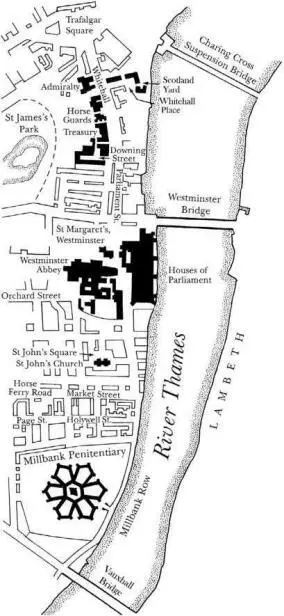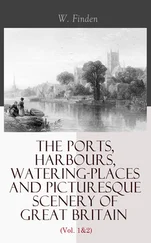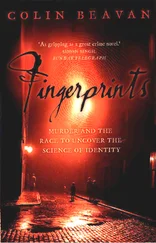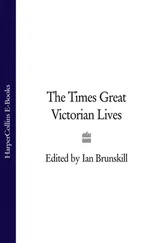
CHAPTER TWELVE
DETECTIVE-FEVER
London, July-August 1860
Whicher reached Paddington station in the afternoon of Saturday, 28 July, and hailed a cab to take him and his luggage to Pimlico - probably to 31 Holywell Street, off Millbank Row. This was the house in which his niece, Sarah Whicher, an unmarried housekeeper of thirty, rented a room, and it was the address he gave as his own three years later.* In the 1850s, his friend and colleague Charley Field lived at number 27, with his wife and mother-in-law, while Whicher's niece Mary Ann worked as a servant to a family of upholsterers at number 40.
The district was changing swiftly. To the west, Victoria railway station was almost complete, and to the north Sir Charles Barry's gothic Palace of Westminster was also nearly finished - the 'Big Ben' clock had been put in place a year before, though as yet it had only one hand and no chime. On the new Westminster bridge thirteen limelight lamps had been installed that summer: these were powered by a series of tiny explosions of oxygen and hydrogen that made the sticks of lime so hot that they burnt white, giving off a brilliant incandescence. Dickens visited Mill-bank one warm day in January 1861, and headed west along the river: 'I walked straight on for three miles on a splendid broad esplanade overhanging the Thames, with immense factories, railway work, and what not, erected on it, and with the strangest beginnings and ends of wealthy streets pushing themselves into the very Thames. When I was a rower on that river it was all broken ground and ditch, with here and there a public house or two, an old mill, and a tall chimney. I had never seen it in any state of transition, though I suppose myself to know this rather large city as well as anyone in it.'
The part of Millbank in which Whicher lived was a noisy, industrial riverside neighbourhood of mean yellow terraces, dominated by the great six-pronged flower of Millbank prison. The novelist Anthony Trollope described the area as 'extremely dull, and one might almost say, ugly'. Holywell Street was separated from the prison's boundary wall only by gasometers, a sawmill and a marble works. Number 31 backed onto these, and faced a huge brewery and a burial ground. Broadwood's piano factory lay a block north, and Seager's gin distillery a block south. Just beyond the distillery, coal barges were moored at the wharfs, while on the far side of the river lay the vast potteries and putrid bone-grinding factories of Lambeth. Paddle steamers carried Londoners to and from work, churning up the sewage poured into the Thames - the air was thick with the stench rising off the river.
On Monday, 30 July, Jack Whicher went to his office at Scotland Yard, just over a mile north of Holywell Street, along the Thames past the noxious slums of the 'Devil's Acre' and then the high buildings of Westminster and Whitehall. The public entrance to the police headquarters was in Great Scotland Yard, though its address was 4 Whitehall Place. There was a large clock on the wall that looked over the yard, a weathervane on the roof, and fifty rooms within. These had housed the Metropolitan Police administration since 1829, and the detective force (in three small chambers) since its formation in 1842. The boarding house that Dolly Williamson shared with other single officers stood in a corner of Great Scotland Yard, behind Groves the fishmongers. In another corner was a public house, outside which a drunken old woman sold pigs' trotters on Saturday nights. To the north of the yard was Trafalgar Square, and to the south the river.
Sir Richard Mayne, whose office was also in Scotland Yard, rated Whicher above all other policemen: in the late 1850s 'every important case was placed in his hands by Sir Richard', reported Tim Cavanagh in his memoirs. Commissioner Mayne, now sixty-six, 'was about five feet eight inches, spare, but well-built', wrote Cavanagh; he had a 'thin face, a very hard compressed mouth, grey hair and whiskers, an eye like that of a hawk, and a slightly limping gait, due, I believe, to rheumatic affection of the hip-joint'. He was 'respected but feared by all in the service'. When Whicher and Williamson got back to work, Mayne duly signed their expenses, including claims for extra pay for being out of town (eleven shillings a day for an inspector, six shillings for a sergeant). The Commissioner passed Whicher a slew of letters from members of the public proposing solutions to the Road Hill case. The letters, addressed to Mayne or the Home Secretary, kept coming throughout the month.
'I beg to offer you an idea which suggested itself to me and which might tend to unravel the mystery,' wrote a Mr Farrer. 'I send it to you in perfect confidence, and hope you will keep my name as its author, a strict secret . . . That Eliz Gough the Nurse may have had William Nutt passing the night with her, and the child (FS Kent) waking up, and fearing he might alarm his parents by crying out, they strangled him, and whilst Nutt conveyed the body to the closet she remade the bed.' Mr Farrer added a postscript: 'As Willm Nutt is connected by marriage with the Laundress' family he may have been enabled to abstract the night dress so as to throw suspicion on another party.'
The theory that Nutt and Gough had killed the boy was, overwhelmingly, the most popular. A writer who thought Constance 'most cruelly used and made a scapegoat' argued that the medical evidence indicated a knife with a ' skew point' had been used in the murder - 'very likely a shoemakers knife very much used.' Nutt was a shoemaker. ' The throat was cut from one ear to the other dividing it all down to the spine, this is more indicative of the power and determination of a man than a nervous girl of 16,' and, 'Shoemakers often have two knives and one might be down the Closet. ' A correspondent from Mile End took a similar view, as did the chaplain of the Bath Union Workhouse, Bath, the master of the workhouse in Axbridge, Somersetshire, Mr Minot of Southwark and a Mr Dalton, writing from a hotel in Manchester. A tailor from Cheshire wanted Gough 'put under strickt servilance'.
A curate from Lancashire, himself a magistrate, gave the fullest account of the theory:
Though the suspicions I am about to mention have frequently from the commencement of the enquiry been broached in my own family, yet I should have thought it unfair to give them wider range had not the public press (the
Morning Post)
hinted at the individual named - I mean in the matter of the Kent murder.
Is it not possible that the nursemaid may have had a paramour either in the house or so well acquainted with the premises that he could gain ready access in the night . . . Of course, from what we have heard one's thoughts fall at once on Nutt . . . If he be an admirer of the girl, should not medical examination establish whether she was likely to have received nightly visits or not? He had all means at command - knives &c - he had the night to work in. He is a connection of the laundress and if the laundress knew of anything going on between these two a suspicion flashed for a moment upon her mind, especially as he had found the body so easily - may she not have been the one to conceal the night-dress and so immediately changed the direction of anything which might then exist in the form of suspicion and fasten it upon that eccentric Miss Kent who sometime ago had run away in man's attire. All these are of course mere suspicions - but when all seems so wide of the mark so far - it leads one to think that the persons employed have gone to work with an a priori view of the case, and rejected or at any rate neglected what did not tell in favour of their own suspicions . . . having had a little experience on the Bench in rather a wild district I have learned to study people's possible motives more than I should otherwise have done.
Читать дальше













